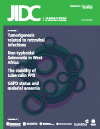Acinetobacter species meningitis in children: a case series from Karachi, Pakistan
DOI:
https://doi.org/10.3855/jidc.1697Keywords:
multidrug-resistant Acinetobacter meningitis, mortality, children, neurosurgical procedureAbstract
Introduction: Multidrug-resistant strains of Acinetobacter pose a serious therapeutic dilemma in hospital practice, particularly when they cause meningitis, as the few antimicrobial agents to which these isolates are susceptible have poor central nervous system (CNS) penetration.
Methodology: We retrospectively reviewed the clinical course and outcome of eight consecutive cases of meningitis due to Acinetobacter spp. in children ages 15 years or less, seen in a tertiary care medical center in Karachi, Pakistan.
Results: Of the eight cases of Acinetobacter meningitis, isolates from five patients were pan-resistant, and two were multidrug-resistant. A neurosurgical procedure was performed in five of eight patients followed by external ventricular drain insertion prior to the development of infection. Seven received intravenous (IV) polymyxin (mean; 12.8 days), while 5/8 also received intrathecal (IT) polymyxin (mean; 12.0 days). The mean length of hospitalization was 38.7 ± 19 days. All patients achieved cerebrospinal fluid (CSF) culture negativity by the end of treatment (mean; 5.4 days). Two patients died: one with pan-resistant Acinetobacter, and the second with a multi-drug resistant isolate.
Conclusion: Post-neurosurgical multidrug-resistant and pan-resistant Acinetobacter meningitis can be successfully treated if appropriate antimicrobial therapy is instituted early. The role of IT polymyxin B administration alone versus combination therapy (IV and IT) needs further study.
Downloads
Published
How to Cite
Issue
Section
License
Authors who publish with this journal agree to the following terms:
- Authors retain copyright and grant the journal right of first publication with the work simultaneously licensed under a Creative Commons Attribution License that allows others to share the work with an acknowledgement of the work's authorship and initial publication in this journal.
- Authors are able to enter into separate, additional contractual arrangements for the non-exclusive distribution of the journal's published version of the work (e.g., post it to an institutional repository or publish it in a book), with an acknowledgement of its initial publication in this journal.
- Authors are permitted and encouraged to post their work online (e.g., in institutional repositories or on their website) prior to and during the submission process, as it can lead to productive exchanges, as well as earlier and greater citation of published work (See The Effect of Open Access).








